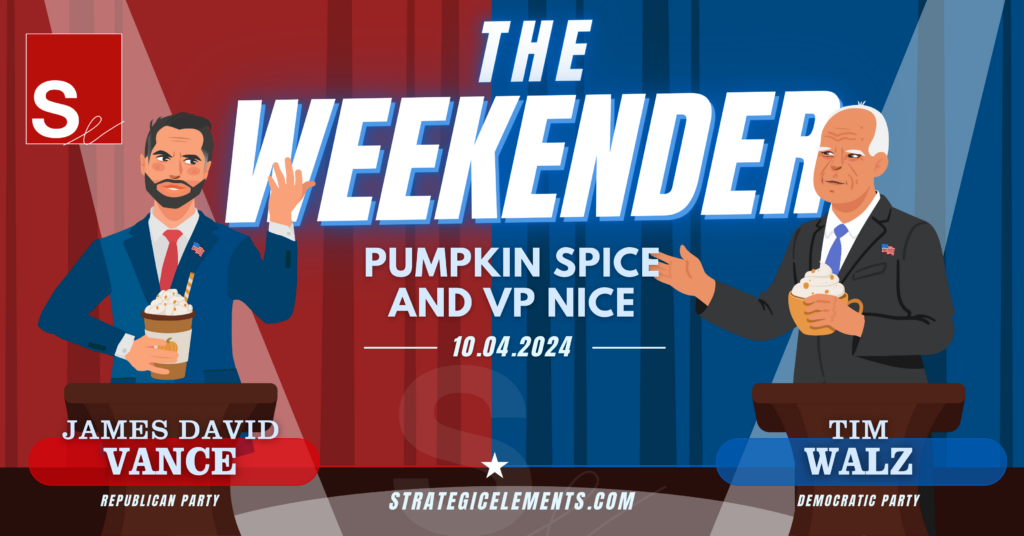DATA POINTS
- 11: The total number of astronauts aboard the International Space Station after two SpaceX astronauts arrived to rescue two stranded Boeing astronauts
- 58: The percentage of likely U.S. voters who plan to vote early in the 2024 General Election
- 88: The percentage of watchers who said the tone of the Vice President debate was generally positive
- 100: The age of Jimmy Carter, the first former U.S. President to reach 100 years old
- 400: The distance Hurricane Helene traveled after making landfall in Florida
- 50,000: The approximate number of ILA longshoremen on strike on the East and Gulf Coast
Clash of the Vice Titans
Vice Presidential candidates JD Vance and Tim Walz went head-to-head in the VP debate on Tuesday night. While the debate is unlikely to move the needle for any voters, it served as an opportunity for the VP wannabees to distinguish themselves and their campaigns. Vance brought a focused, clear-headed, and polished approach to the debate. He was courteous to not only his opponent, but also the moderators (save for pushing back on fact-checking, which was a function moderators agreed to not perform). Despite Walz’s shaky start, he found his groove in climate change, abortion rights, and immigration. His brightest (and most practiced) remarks came when discussing January 6 and the 2020 election.
Perhaps the most memorable moments of the debate were the moments of uncommon cordiality. Vance showed genuine empathy and humanity when responding to Walz’s comment about his son witnessing a shooting. Walz noted that he agreed with Vance several times, and both avoided name calling and overtly personal attacks.
To the relief of the candidates, both were spared having to deal with their own albatrosses. Walz did not face music pertaining to his military record nor did Vance have to reiterate his claims of Walz’s “stolen valor.” Vance also did not have to clarify his “childless cat ladies” quote from 2021.
Vance’s performance was strong enough that it likely made it less likely his boss would agree to another debate with Harris before November. While it’s unlikely, doing so would mean that he, not Vance, would have the last word before polls open.
 AI’s Energy Insatiability
AI’s Energy Insatiability
Did you know that a search on a generative AI engine like ChatGPT uses at least 10 times the amount of energy as a Google search? As the tip of the innovative spear in the modern economy, tech companies yearn for more clean energy every day. The AI revolution is taking place, but the data centers powering them are power-hungry (if not insatiable). It’s no surprise companies like Amazon, Google, and Microsoft are looking to tap into as many clean energy installations as they can get their hands on.
The U.S. is far and away the epicenter of the data center world with 2,800 locations. The U.K. is the next closest with 400 data centers. Each data center brings jobs, increased property values, economic development, a more resilient energy grid, and more, especially helping light a fire in Midwestern economies. The caveat is that they will nearly always choose locations with abundant clean energy they can purchase through power purchase agreements.
Big Tech is rushing to meet the needs of the modern internet and is using renewable energy to do so. The question remains – as AI requires more power every day, will the U.S. develop clean energy projects fast enough to keep up? To do so, modifications will need to be made to state and local permitting processes. Big tech is hungry and growing. If rural America wants the revenue and jobs that the projects bring, they must be able to provide the clean, affordable energy they demand.
Read More at The Wall Street Journal
Turn $1 into $1,135 (in 30 Years)
Wall Street investors are celebrating – the stock market is performing exceptionally well. Last year, the 30-year return for the S&P 500 was 834%. Today, the return over the same period is 1,135%, rising over 12 times itself in the past 30 years.
This is an all-time high record for the S&P. The stock market is up 34% over the past year and 20% YTD. No matter the size or age of the portfolio, this is great news for all investors.
Happy Fall! The Rise of Pumpkin Spice
Ah, fall – the season of cozy sweaters, crisp air, and, of course, pumpkin spice everything. Since Starbucks first introduced the Pumpkin Spice Latte (PSL) in 2003, the beloved flavor has become a cultural icon, even though there is very limited pumpkin in the mix. For many, it’s hard to imagine fall without this blend of cinnamon, nutmeg, ginger, and cloves dominating the market in drinks, doughnuts, muffins, and creamers.
What started as a coffee experiment in Starbucks’ “Liquid Lab” became a $500 million industry. But why does pumpkin spice have such a hold on fall culture? Perhaps it’s nostalgia – a sip of a pumpkin spice latte brings up images of autumn leaves, cozy blankets, pumpkin patches, and holiday baking. Or maybe it’s the ritual – fall isn’t complete for many without the warm hug of pumpkin-flavored treats.
This flavor is so loved that it has earned its own day: October 1 is National Pumpkin Spice Day. Call it what you will – a marketing ploy or a cultural moment – pumpkin spice is here to stay.
You’ve Got Scammed
Online scams are surging, targeting people through the most personal and accessible device: the smartphone. Scammers use tricks called “social engineering” to fool people into giving up personal information or money by playing on emotions like fear or trust. These scams can happen through emails, text messages, or even social media quizzes that seem harmless but are designed to gather your details. Many people have recently received text messages with a link claiming their package is out for delivery, but it’s often for a package they never ordered and part of a scam. And our constant tie to our mobile devices makes it easier for scammers to connect and trick people.
With more entry points than ever—text messages, social media, and even dating apps—scams are becoming increasingly sophisticated. That fun quiz you took on Facebook? It could have been created by criminals phishing for your personal details. And they’re only getting more creative.
So, how can you protect yourself? Be cautious when clicking on links, double-check who’s contacting you before sharing personal information, and use security tools like antivirus software. If you do get scammed, report it as soon as possible. Taking quick action can prevent further damage. Staying alert and aware is the best way to protect yourself from online scams.
Read More at The New York Times
See you next week!
Be sure to follow us on Facebook, Twitter, and LinkedIn for more news and industry updates. To receive a copy of The Weekender in your inbox, sign up here.





 AI’s Energy Insatiability
AI’s Energy Insatiability 



